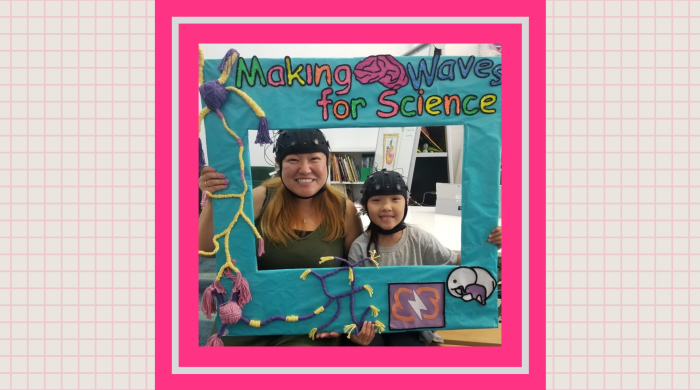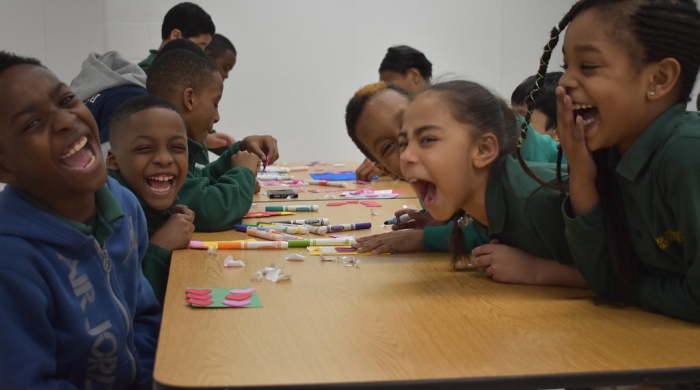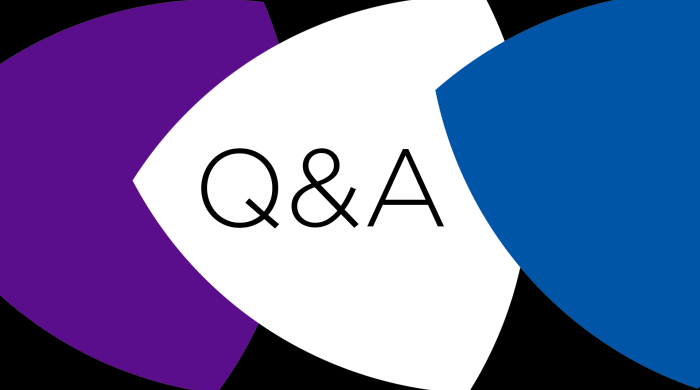
Since 2014, researchers at the Institute of Human Development and Social Change and Educational Alliance have partnered to build capacity for community-based programs that support children, caretakers, and families living in poverty. On the Ground spoke to Dr. Erin Godfrey, IHDSC Director, and Dr. Andrew Cavanagh, Educational Alliance’s Director of Research and Evaluation, about the resilience of their longstanding partnership and how their collaboration has benefitted the communities they serve. Their conversation was edited for clarity and length.
Before we get into the specifics of the partnership, how has the relationship between IHDSC and Educational Alliance benefited the communities you serve?
Cavanagh: One of the key findings from the work that we've done with Erin was with respect to family literacy programming. We have family literacy programs with adults, caregivers, and children in classrooms, reading together and exploring different books and activities around literacy.
We want to find more and more opportunities to have adults and children reading together, in part because this project has allowed us to identify work that is leading to meaningful change for families. Seeing positive impacts led to expanding that work to families who have children in kindergarten through age five.
Godfrey: Through the partnership, we were able to talk to immigrant families. They gave us a clear sense that the English language classes that they were taking were really important to them. The classes increased people's sense of belonging and of being able to navigate the city to access the resources that their family needed. They were more comfortable helping their children with their schoolwork. They are able to describe why this element was really important and should continue to be part of the programming. It added to the conceptualization of the ways in which our work could impact families. And it was driven by the families’ voices themselves.
Why has the partnership strengthened over the years?
Cavanagh: Educational Alliance has a 130-year history as a settlement house in the Lower East Side. We were one of the initial pilot grantees in 1965 and had one of the first Head Start programs in the country. We have a long history in providing these services, but a relatively short history in understanding, researching, and evaluating how those programs are ultimately benefiting the people we're serving and understanding what pieces are more effective or less effective.
That necessitates nitty gritty data work. When you're talking about multi-generational support, you need a database and system that reflects that complex work. We track information at the child level and the caregiver level.
Historically, nonprofit organizations and community-based organizations that do this work are really understaffed and under capacity. Erin can translate her expertise in the field and what she understands from her experience, and I can serve to translate what we're seeing on the ground in real time and what we're learning. That is what really sustains the work. We have the ability to work together on questions that we ask real people.
Godfrey: Communication was absolutely essential around issues of data, quality, and capacity building. How do we ask and answer evidence-based questions, but in the real-world practice arena? What are the data systems that we need? How do we need to code this data? How do we access it again in ways that will allow Educational Alliance to use that data for their programmatic purposes, but also to allow it to be more easily used for research purposes to track outcomes and impact over time?
Cavanagh: IHDSC really does have the bona fides in terms of training, skill, and expertise in evidence-based high-quality research, practice, and procedure. Erin and her students could take a very honest look at what we had to offer in terms of data and give us a clear assessment of what wasn't working and then make recommendations that fit in with what our program's goals were. Then on our end, we have the structures in place and in our organizational chart to be able to have conversations with the right people to make those changes work. If Educational Alliance were to do that all by ourselves, it would be really hard. Having an objective third party like NYU come in and say something really carries a different weight than an internal conversation.
What objectives that Erin and her colleagues flagged as priorities did you put into practice?
Cavanagh: It's stuff that you wouldn't think about but really is critical to the thinking of program staff who are really focused on providing the best service possible. Do we have correct IDs for everybody in our system? Can we link everyone to an individual identifier with an ID number, with a date of birth and a correctly spelled name? We're looking through these lists with people who wrote down nicknames, who wrote down their name in their native language rather than in English. At one point, our program had nine people with the same first and last name from nine different families. There was a need to make sure that each individual was coded to the right family in the right classroom for the right years.
Godfrey: Another area that we worked on is understanding the impact that programs have on families. We needed to survey folks and have them report back on things that changed in the way they live their life or parent their children or feel about themselves or their future.
How can we collect that information in a systematic way? What is the theory of change that would help us understand the right areas to ask about? Should we do it twice a year or three times a year? It's the logistics of data collection and balancing the logistics between the practice and programmatic realities.
Cavanagh: Educational Alliance can, in theory, make all of those decisions on our own as an agency. But it would take us a really long time to do, and we would be doing it in a vacuum without real understanding of the implications. Erin is wonderfully strategic in how the decisions that we're making have consequences and working through those trade-offs.
Godfrey: It was really the first time I really understood the on-the-ground realities. It really enabled me to get close to the people and to the experience of service delivery in a really different way. Being in this partnership and thinking through all the ins and outs from both sides was really eye-opening and important to understand.
Cavanagh: In other partnership cases, a university professor may contact a community-based organization they’re serving people in a way that is consistent with the researcher's interests. The professor parachutes in, completes the work in a couple of weeks or over the course of a year. Then they go back to their research, write it up, and maybe send the organization a top-line report that says what they found.
That example is in a different universe than the work that IHDSC and Educational Alliance is doing. We’re getting down to the person level and understanding the things that are happening for the people that we're serving and connecting all those things to what is happening in the program. We then have opportunities to tell the story of partnerships so that it's not just the researcher writing the report that they had intended to write. It's us writing that report completely in partnership.
How has the partnership benefitted your respective research and other partnered work?
Cavanagh: Last Friday, I had a call with a researcher from another institution in the city and I was able to confidently go into that discussion saying, "Here's what we want from you," just as much as "What can we do for you?" That is going to continue to inform our partnership conversations moving forward.
Godfrey: There are huge benefits and huge changes that sound small but are actually big. Whether you're teaching undergraduates, masters, or doctoral students, you talk about these issues, right? There's a lot of discussion of principles and articles that you would read, but it doesn't mean anything until you've been in that experience yourself and really deeply involved in the work. I found myself going back to partnership articles and those discussions that I had as a graduate student or that I've given to my own students and saying, “This point means so much more now to me now than it ever used to.”
I think the other main thing is data. Students are often used to these pristine datasets, with very complex, sophisticated, quantitative analysis. But real, messy data is not trained nearly as much in most programs as it should be, and this is a great training ground for that.
Some of my students have learned by working with Educational Alliance's data and trying to make things line up. They identify the issues and problem solve and troubleshoot in a way that will be incredibly helpful to collecting their own data in the future. Learning all those skills in a way that is super firsthand is really incredibly valuable and has really informed the way I teach and launch research.
Cavanagh: I would note the importance of a university collaboration and giving a voice to a community-based organization. Educational Alliance always has confidence in the work that we do and the people that we're serving. We're doing the right work for the right people. This partnership with Erin and IHDSC has allowed us to find a voice in different areas to be able to tell our story.
We're working on public peer-reviewed publications that allow us to have a foothold in the literature for the first time in the 130-year history of our agency. Opportunities like that and the chance to interact with other NYU researchers are really exciting.
Godfrey: If we're really caring about work with applied impact that is responsive, rigorous, and relevant, then this is exactly the kind of experience that graduate students need. It is extremely important for my students to have that real on-the-ground lived experience. That is an extremely important part of training that's really difficult to get otherwise.
Cavanagh: The reality is that this work that gets done to actually change people's lives is very very messy and accounts for a broad spectrum of personal characteristics, experiences, and resulting outcomes.
Interested in Partnering?
Complete our partnership inquiry form.Other Partnership Blogs
Studying STEM in Sunset Park
IHDSC spoke with Dr. Natalie Brito and Sunset Spark — a Brooklyn-based non-profit— about their partnership, the importance of diverse and representative samples, and the benefit of conducting research in community-based settings.
Partnering to Improve Afterschool
What role can afterschool programs play in addressing inequality and promoting opportunities? The Advancing Collaborative Research in Out-of-School Settings (ACROSS) partnership represents a unique partnership between researchers from The Institute of Human Development and Social Change and Good Shepherd Services. Read a Q&A with Dr. Miranda Yates, Dr. Elise Cappella, and Sophia Hwang.
Research Partnerships: Dr. Dillon & MoMath
Dr. Moira Dillon and Cindy Lawrence, Executive Director of the National Museum of Mathematics, received an IHDSC Seed Award to recruit children for interactive in-museum experiments to investigate how children reason about the general properties of geometric figures. Dillon and Lawrence talk about the process of developing their research partnership.




